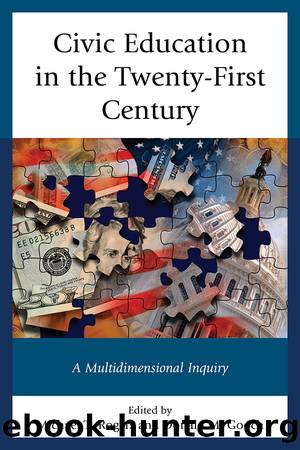Civic Education in the Twenty-First Century by unknow

Author:unknow
Language: eng
Format: epub
Publisher: Lexington Books
Published: 2015-08-15T00:00:00+00:00
Chapter Ten
Encouraging Civic Participation of Citizens through County Websites
A Case Study of Arkansas
Barbara Warner*
Encouraging civic participation by citizens does not just happen through time-honored traditional vehicles. It can also be done at various levels through e-government. As defined by Curtin et al., e-government is âgoverning populations through the use of online information and services.â1 One of the vehicles for this is county websites. Counties are not only an important level of government in terms of the activities they oversee and manage, but they are an understudied area when it comes to e-government. As Aroon Manoharan points out, the literature on e-government offers little relating specifically to the adoption of websites by county governments in the United States.2
Of the fifty U.S. states, forty-eight have operational county governments.3 Although the 3,069 counties differ in their governance, structure, and responsibilities, they provide and administer numerous services that include elections, transportation and infrastructure, public facilities and utilities, education, justicial and correctional services, healthcare, coordination with other levels of government and nonprofit organizations, record-keeping and more.4 What is more, counties serve as geographical approximations for congressional redistricting.
County governments are also the loci of the evolution of great societal trends in the nation, especially in regions that have seen dramatic population increases that have resulted in a fight for expanded governing powers.5 Moreover, counties as a whole have more than 19,300 elected board members and elected executives, they invest $482.1 billion a year in providing services for 296 million residents, and they rely upon 3.3 million employees; yet they face limited resources.6 Finally, counties are seen as the most flexible, locally responsive and creative of the various types of governance systems in the United States. Their politics and policies are seen as typifying the idea of thinking globally and acting locally.7
Despite the reach, power, and potential of counties, the types of e-government communication currently used by local governments are rarely monitored or analyzed.8 And yet, as Chadwick notes, when it comes to community deliberation and participation, the Internet appears to offer both increasing and decreasing opportunities for political participation. Chadwick concludes that âe-democracy in communities is producing more complex, rather than simply more or less . . ., political participation.â9 Yet Curtin et al. say that necessary components of e-government include governmental accountability, accessibility, transparency, and collaboration, which include the ability of citizens to vote and to monitor their government. They are strong advocates of e-government for increasing civic participation and highlight the significant advancement by counties in this area.10
Given the importance of e-government and of counties, this chapter uses Arkansas county websites as a case study to analyze counties as drivers of civic participation, in particular the promotion of citizen voting and monitoring of their government. Arkansas is a fruitful source for the study of county e-government because it has three of the fastest growing counties in the nation, according to the U.S. Census Bureau. It is also a growing economic force (home to the largest retailer in the world [Walmart] and the nationâs largest poultry and meat processor [Tyson Foods].
Download
This site does not store any files on its server. We only index and link to content provided by other sites. Please contact the content providers to delete copyright contents if any and email us, we'll remove relevant links or contents immediately.
The Art of Coaching Workbook by Elena Aguilar(48571)
Trainspotting by Irvine Welsh(20140)
Twilight of the Idols With the Antichrist and Ecce Homo by Friedrich Nietzsche(17754)
Fangirl by Rainbow Rowell(7893)
Periodization Training for Sports by Tudor Bompa(7376)
Change Your Questions, Change Your Life by Marilee Adams(6702)
This Is How You Lose Her by Junot Diaz(5844)
Grit by Angela Duckworth(4777)
Red Sparrow by Jason Matthews(4734)
Asking the Right Questions: A Guide to Critical Thinking by M. Neil Browne & Stuart M. Keeley(4641)
Paper Towns by Green John(4209)
Room 212 by Kate Stewart(4152)
Ken Follett - World without end by Ken Follett(4003)
The Sports Rules Book by Human Kinetics(3630)
Housekeeping by Marilynne Robinson(3455)
The Motorcycle Diaries by Ernesto Che Guevara(3379)
Exercise Technique Manual for Resistance Training by National Strength & Conditioning Association(3329)
Introduction to Kinesiology by Shirl J. Hoffman(3328)
Papillon (English) by Henri Charrière(3321)
